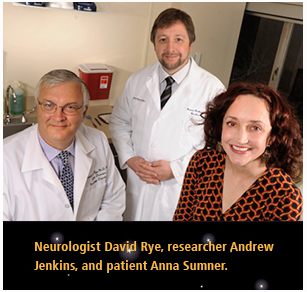Anesthesiologist Paul Garcia and his colleagues are presenting two posters at the Society of Neuroscience meeting this week, whose findings may raise concerns about two non-stimulant drugs Emory sleep specialists have studied for the treatment of hypersomnia: flumazenil and clarithromycin.
For both, the data is in vitro only, so caution is in order and more investigation may be needed.
With flumazenil, Garcia and colleagues found that when neurons are exposed to a low dose for 24 hours, the cells increase expression of some GABA receptor forms.
This could be part of a mechanism for tolerance. I heard some anecdotes describing how flumazenil’s wake-promoting effects wear off over time at the Hypersomnia Foundation conference in July, but it’s not clear how common the phenomenon is.
Flumazenil’s utility in hypersomnia became known after the pioneering experience of Anna Sumner, who has reported being able to use the medicine for years. See this 2013 story in Emory Medicine. Read more







